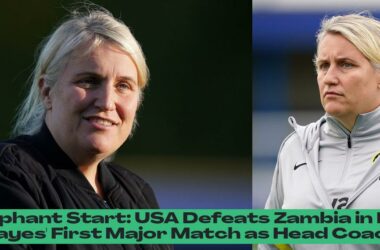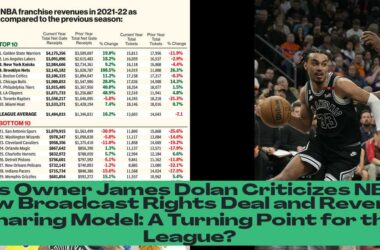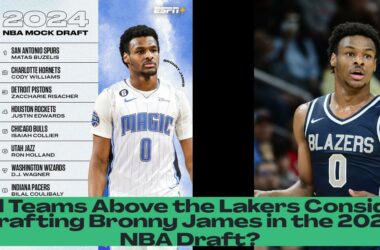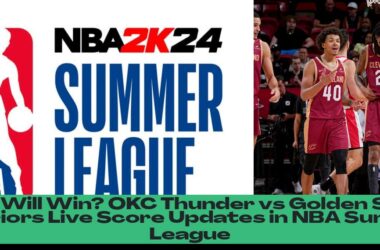Why Brandon Ingram is the NBA’s First True Test of the New CBA’s Max Player Definition
Brandon Ingram. The name alone evokes intrigue and debate in NBA circles. A player with undeniable talent and the physical attributes of a superstar, Ingram has long been a subject of fascination for teams and fans alike. His career trajectory, however, has been anything but linear. While his early years were marked by flashes of brilliance, his consistent performance has been a source of continuous speculation, culminating in a perplexing situation right now – the NBA seems to have lost interest in him, at least in the realm of max contracts.
The facts are undeniable: throughout his career, Ingram has carried significant trade value. Teams have consistently seen him as a potential cornerstone piece. However, the current landscape of the NBA paints a different picture. Ingram is eligible for a four-year, $208 million contract extension this offseason, and the whispers are that he wants that max money. Yet, the Pelicans, the team currently holding his rights, seem hesitant. Other suitors, like the Hawks and Warriors, have reportedly declined his services, raising a critical question: Why has the NBA seemingly lost interest in a 26-year-old former All-Star playing the league’s scarcest position?
The answer, in a nutshell, is money. The NBA’s new collective bargaining agreement (CBA) has ushered in an era of unprecedented fiscal responsibility, forcing teams to be more cautious with their spending, especially on max contracts. The luxury tax aprons, which penalize teams that exceed certain salary cap thresholds, have created a palpable sense of financial constraint across the league. The risk of exceeding these thresholds is simply too great for most teams to stomach.
Ingram’s case presents a unique challenge. While he possesses undeniable talent, his performance has been inconsistent. While he can score a lot of points and boasts impressive athleticism, his shot selection and defensive consistency have been questioned. Most importantly, the new CBA has shifted the paradigm of what constitutes a max-worthy player. Teams are now more hesitant to commit such significant financial resources to players who haven’t consistently demonstrated top-tier production.
In the past, teams were more willing to pay players with high potential, hoping they would eventually reach their ceiling. However, the new CBA’s financial constraints have made such investments riskier. Teams are now more inclined to prioritize proven stars who can contribute to immediate success, rather than gamble on players with unfulfilled promises.
- Brandon Ingram is the NBA’s first true test of what defines a max player under the new CBA.
- The NBA’s new collective bargaining agreement has made teams more cautious with their spending, especially on max contracts.
- Ingram’s eligibility for a $208 million contract extension has raised questions due to his inconsistent performance despite undeniable talent.
- Teams are now more hesitant to commit significant financial resources to players who haven’t consistently demonstrated top-tier production.
- The risk of exceeding luxury tax aprons has created financial constraints across the league, impacting decisions on max contracts.
- Ingram’s case highlights the shift in what constitutes a max-worthy player in the current NBA landscape.
Ingram’s Predicament: A Paradigm Shift in Max Contracts
Ingram’s predicament is a microcosm of the NBA’s changing landscape. The max contract, once a symbol of elite status in the league, is now a more discerning honorific, reserved for players who not only possess the talent but also consistently deliver at a high level. Ingram, despite his undeniable potential, hasn’t met those criteria consistently. His reliance on mid-range shots, inconsistent defense, and occasional lapses in shot selection have raised concerns among teams, leaving them hesitant to offer him the max.
The new CBA has essentially created a new benchmark for max players. Teams are now looking for players who can not only be the top scorer on their team but also demonstrate defensive versatility, efficient shot selection, and a commitment to winning. Ingram, while displaying flashes of brilliance, hasn’t consistently hit all of those marks, making teams cautious about offering him that coveted max contract.
The league has witnessed a shift in the perception of “max-worthy” players. The days of paying players based solely on potential are fading. Teams are now more focused on immediate results and financial sustainability, making them more cautious about investing in players who haven’t proven themselves to be consistent top-tier performers. This new CBA has created a more stringent evaluation process, requiring players to not only have the talent but also the consistency and all-around skillset to justify a max contract.
Ingram’s case is a stark reminder that the NBA is no longer solely about potential. The new CBA has instilled a sense of financial prudence in teams, making them more cautious about max contracts. Players like Ingram, who are talented but not consistently elite, are facing a new reality, where the max contract is no longer a given, but rather a hard-earned reward for consistent, all-around excellence.
The Impact on Other Players and the Future of Max Contracts
Ingram’s situation is not an isolated case. Other players, like Julius Randle, Michael Porter Jr., and Karl-Anthony Towns, are facing similar challenges. These players are talented but have yet to consistently perform at a level that justifies a max contract in the new CBA. Teams are now more aware of the financial ramifications of max contracts and are hesitant to commit to players who haven’t demonstrated that they can be the cornerstone of a championship team.
The impact of the new CBA on the max contract market is significant. Teams are now more careful about handing out max contracts, reserving them for players who have a proven track record of success. This shift in approach is likely to have a long-term impact on the league, as teams become more strategic in their financial decisions. The days of paying players based solely on potential are fading, replaced by a new era of financial prudence and a focus on consistent, high-level performance.
The future of max contracts in the NBA is likely to be characterized by a greater emphasis on proven production and all-around excellence. Teams will be more discerning in their choices, seeking players who can not only score but also contribute in other areas, such as defense, shot selection, and leadership. The new CBA has fundamentally changed the landscape of max contracts, making them a more exclusive club, accessible only to players who consistently deliver at the highest level.
What Does the Future Hold for Ingram?
So, where does this leave Brandon Ingram? His future, at least in the immediate term, seems uncertain. The Pelicans appear hesitant to offer him a max contract, and other teams are also showing reluctance. It’s possible that Ingram could find a team willing to take a gamble on his potential, but the odds seem to be stacked against him in this new era of financial restraint.
However, Ingram’s situation could also be a turning point for him. The pressure to perform at a level worthy of a max contract could motivate him to elevate his game. If he can improve his consistency, enhance his defensive presence, and refine his shot selection, he could still become a max-worthy player in a league that values all-around excellence.
Ultimately, Ingram’s future will depend on his own performance and how he adapts to the new reality of the NBA. He has the talent to be a superstar, but he needs to consistently demonstrate that he can be the cornerstone of a championship team. If he can do that, he will find his place in the league, even if it doesn’t come with the max contract he desires.
Ingram’s journey is a compelling story, a microcosm of the NBA’s evolution. The new CBA has created a new paradigm, where potential is no longer enough to justify a max contract. Players like Ingram must now consistently deliver at a high level, proving themselves worthy of the financial commitment that comes with a max deal. The NBA landscape has shifted, and Ingram’s story is just beginning to unfold in this new era.









